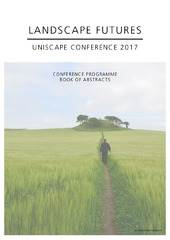Приказ основних података о документу
Belgrade Riverscape Revisions and Lost Perspectives of Modernisation
| dc.creator | Milinković, Marija | |
| dc.creator | Dragana, Ćorović | |
| dc.date.accessioned | 2023-12-29T11:18:13Z | |
| dc.date.available | 2023-12-29T11:18:13Z | |
| dc.date.issued | 2017 | |
| dc.identifier.uri | https://raf.arh.bg.ac.rs/handle/123456789/1926 | |
| dc.description.abstract | On the 24 of January 2017, the new strategy of the re-design of the urban park Ušće (the Confluence), that belongs to the central green zone of Belgrade was presented to the city government. The future landscape project for this space will be authored by the prominent and global urban design firm Gehl Architects. Before the project becomes available to the public, we investigate the intrinsic qualities and values of the existing space in perspective of the Belgrade urban modernisation. During the nineteenth century, Belgrade was a city on a water border-line between the Ottoman Empire, respectively the Principality/Kingdom of Serbia and the Habsburg Monarchy. There was a radical transformation of the city’s urban landscape during this period and the process was driven for the most part by the paradigm of the modern European city. The protagonists of the transformation, the bearers of political and economic power, were following the patterns of a capitalist development of the state. After the end of the World War One, Belgrade was the most densely populated city and the city with the greatest mechanical inflow of population in the newly established Kingdom of Serbs, Croats, and Slovenes (1918–1929), in the Kingdom of Yugoslavia (1929–41), as well as after World War Two in the Socialist Yugoslavia. The construction of New Belgrade on the right bank of the Danube River, at the deserted space between Belgrade and Zemun (which until 1918 was part of Austria-Hungary) progressed according to the initial concept by the prominent Yugoslav town planner and architect Nikola Dobrović, 1946–48. In all these periods of urban landscape transformation, the main buzzword that has justified the different kind of spatial interventions was expressed by the saying: Belgrade must descents to its rivers. In this context we compare contemporary visions of the Danube riverfront of New Belgrade with the insightful concept from the very beginning of the twentieth century for the Danube suburban neighbourhood in the old Belgrade that reveals the valuable clues of the lost layers in the perpetual metamorphosis of an urban riverscape. | sr |
| dc.language.iso | en | sr |
| dc.publisher | Department of Geosciences and Natural Resource Management, Section for Landscape Architecture and Planning, University of Copenhagen | sr |
| dc.publisher | Firenze: UNISCAPE | sr |
| dc.publisher | Oslo: Centre for Landscape Democracy (CLaD), Norwegian University of Life Sciences | sr |
| dc.rights | openAccess | sr |
| dc.source | Landscape Futures UNISCAPE Conference : conference programme : book of abstracts, June 19-21 | sr |
| dc.subject | Belgrade Riverscape | sr |
| dc.subject | Danube | sr |
| dc.subject | Urban Modernisation | sr |
| dc.subject | Landscape Revisions | sr |
| dc.title | Belgrade Riverscape Revisions and Lost Perspectives of Modernisation | sr |
| dc.type | conferenceObject | sr |
| dc.rights.license | ARR | sr |
| dcterms.abstract | Драгана, Ћоровић; Милинковић, Марија; Белграде Риверсцапе Ревисионс анд Лост Перспецтивес оф Модернисатион; Белграде Риверсцапе Ревисионс анд Лост Перспецтивес оф Модернисатион; | |
| dc.citation.spage | 53 | |
| dc.citation.epage | 53 | |
| dc.identifier.fulltext | http://raf.arh.bg.ac.rs/bitstream/id/6747/2017_LandscapeFutures_BookofAbstracts_mmdc.pdf | |
| dc.identifier.rcub | https://hdl.handle.net/21.15107/rcub_raf_1926 | |
| dc.type.version | publishedVersion | sr |

